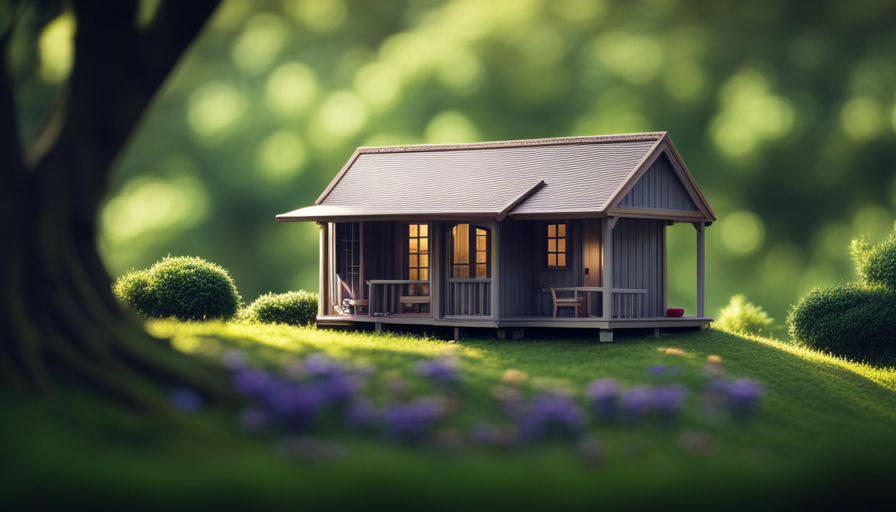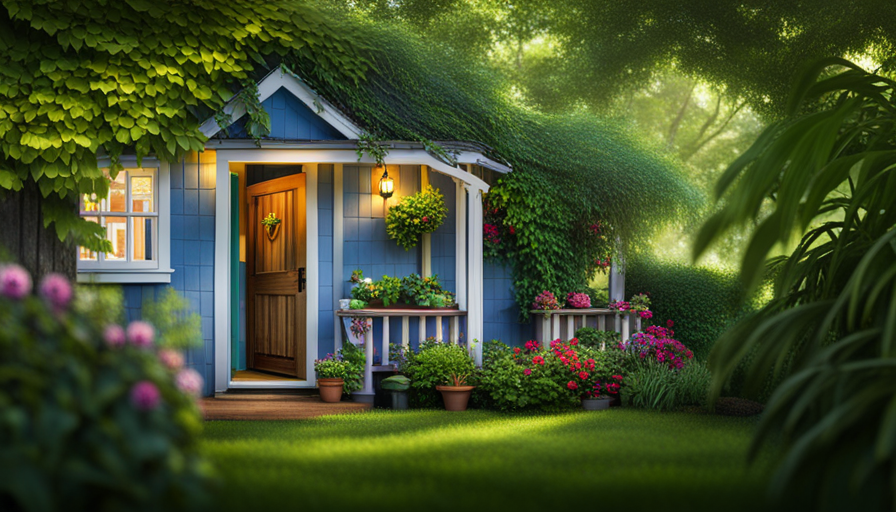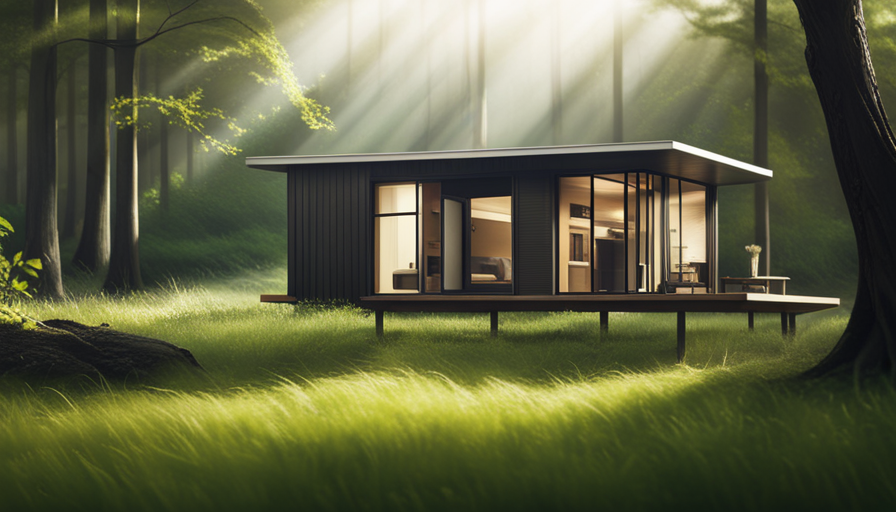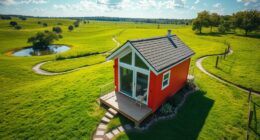Are you thinking about buying a small home? Well, I happen to have some valuable insights to share with you. Is it just a coincidence? Not really.
As someone who has successfully navigated the process of acquiring a tiny house, I can offer you some guidance on how to make your dream a reality.
First things first, determining your budget and exploring financing options is crucial. With the right plan in place, you’ll be well on your way to finding the perfect tiny house design and style that suits your needs. Don’t worry, I’ll help you research the best options out there.
Finding a reputable builder or manufacturer is essential to ensure a quality tiny house. And let’s not forget about the land and zoning regulations you need to consider. But don’t worry, I’ll walk you through all the necessary steps.
Once you have your tiny house, it’s time to customize it to fit your lifestyle and plan for utilities and off-grid living if that’s your thing. And of course, I’ll give you some tips on transitioning to a smaller living space and the logistics of moving and transporting your tiny house.
Are you ready to embrace the minimalist lifestyle and enjoy the freedom that comes with owning a tiny house? Let’s get started on this exciting journey together!
Key Takeaways
- Determine your budget and explore financing options to make your tiny house dream a reality.
- Research and find a reputable builder or manufacturer for a quality tiny house.
- Consider land availability and zoning regulations when deciding where to place your tiny house.
- Customize your tiny house to fit your lifestyle and make the most of the space available.
Determine Your Budget and Financing Options
Figure out how much you can afford and explore different ways to finance your tiny house. When it comes to alternative housing options, tiny houses have gained popularity in recent years. However, before diving into this unique lifestyle, it’s important to understand the costs and benefits of tiny living.
Determining your budget is the first step. Take a comprehensive look at your finances and decide how much you can comfortably invest in a tiny house. Consider factors such as construction costs, land purchase or rental fees, and ongoing expenses like maintenance and utilities. It’s crucial to be realistic and ensure that your budget aligns with your financial capabilities.
Once you have a budget in mind, explore financing options. Traditional banks may not readily provide loans for tiny houses, as they are considered unconventional. However, there are alternative financing methods available. Look into personal loans, peer-to-peer lending platforms, or crowdfunding campaigns to fund your tiny house project.
Understanding the costs and financing options will help you make informed decisions as you embark on your tiny house journey. Now that you have a budget and financing plan in place, it’s time to research different tiny house designs and styles. This will allow you to find the perfect match for your needs and preferences, ensuring a comfortable and enjoyable tiny living experience.
Research Different Tiny House Designs and Styles
Explore various architectural blueprints and floor plans to familiarize yourself with the diverse array of designs and styles available for compact dwellings. When it comes to tiny houses, the interior design plays a crucial role in maximizing space and creating a functional living environment.
Look for designs that prioritize efficiency and utilize clever storage solutions. From lofted bedrooms to built-in cabinets and multipurpose furniture, there are countless ways to make the most of limited square footage. Consider your needs and preferences, whether it’s a minimalist aesthetic or a cozy rustic feel, and find a design that aligns with your vision.
In addition to the overall layout, pay attention to specific features and elements that can enhance your tiny house experience. Consider options like hidden storage compartments, folding tables, and convertible seating to optimize space utilization. Look for designs that incorporate natural light through strategically placed windows and skylights, creating an illusion of openness and airiness. Don’t forget to consider the materials and finishes that match your style, whether it’s sleek and modern or warm and rustic.
As you explore different designs and styles, keep in mind that you will eventually need to find a reputable tiny house builder or manufacturer to bring your vision to life. While researching, take note of builders who specialize in the style you’re interested in, ensuring they have a track record of quality craftsmanship and customer satisfaction. By combining your knowledge of designs and styles with a trusted builder, you’ll be one step closer to turning your tiny house dreams into a reality.
Find a Reputable Tiny House Builder or Manufacturer
When you embark on the journey of bringing your dream compact dwelling to life, finding a reputable tiny house builder or manufacturer is like discovering the architect who holds the key to unlocking the doors of your future sanctuary.
With the growing popularity of tiny houses, there is no shortage of options when it comes to choosing a builder or manufacturer. It is important, however, to carefully research and consider your choices in order to ensure a successful and enjoyable experience.
There are two main options to consider when looking for a tiny house builder: custom builders and pre-fabricated manufacturers. Custom builders offer the flexibility to design a tiny house that perfectly suits your needs and preferences. They work closely with you to create a one-of-a-kind home that reflects your personal style.
On the other hand, pre-fabricated manufacturers offer a more streamlined process. They have pre-designed models to choose from, which can save time and potentially reduce costs.
When selecting a builder or manufacturer, it is crucial to do your due diligence. Look for companies with a solid reputation and positive customer reviews. Check if they have any certifications or affiliations that demonstrate their expertise and commitment to quality. Don’t be afraid to ask for references and visit completed projects to see the quality of their work firsthand.
As you consider your options for a tiny house builder or manufacturer, it’s also important to think ahead to the next step: considering your land and zoning regulations. This will ensure that you are prepared for the next phase of turning your tiny house dream into a reality.
Consider Your Land and Zoning Regulations
It’s crucial to take into account your land and zoning regulations before moving forward with your tiny house plans.
When it comes to finding the perfect spot for your tiny house, land availability plays a significant role. You need to consider factors such as accessibility, proximity to amenities, and the overall suitability of the land for your tiny home. Consider whether you want to live in an urban or rural area, and if you prefer to own or rent the land.
Additionally, understanding the building permits and zoning regulations in your area is essential. Different regions have different rules regarding the size, placement, and construction of tiny houses. You may need to obtain permits or variances to legally place your tiny house on your chosen land. It’s important to research and understand these regulations to avoid any legal issues down the road.
Once you have a clear understanding of your land and zoning regulations, you can move on to the next step of customizing your tiny house design to fit your needs.
Customize Your Tiny House Design to Fit Your Needs
Once you’ve truly grasped the ins and outs of your land and zoning regulations, you can start tailoring your pint-sized abode to perfectly suit your desires. Customizing features and optimizing space are crucial aspects of designing your ideal tiny house. With limited square footage, every inch counts, so it’s important to carefully consider your needs and prioritize functionality.
To help you visualize the possibilities, here’s a table showcasing some common customizations and space optimization techniques:
| Customization | Description | Benefits |
|---|---|---|
| Lofted Sleeping | Utilizing vertical space for sleeping quarters | Maximizes floor space |
| Multipurpose Furniture | Furniture that serves multiple functions | Saves space and adds versatility |
| Creative Storage Solutions | Incorporating hidden storage compartments | Keeps belongings organized and out of sight |
| Open Floor Plan | Removing interior walls to create a more spacious feel | Enhances the sense of openness |
As you can see, there are various ways to personalize your tiny house. Whether it’s adding a lofted sleeping area, investing in multipurpose furniture, utilizing creative storage solutions, or opting for an open floor plan, the possibilities are endless.
Now that you have a better understanding of customizing features and space optimization, it’s time to secure financing or funding for your tiny house. Transitioning into the next section, it’s important to explore the various options available to make your tiny house dream a reality.
Secure Financing or Funding for Your Tiny House
To bring your tiny house dreams to life, you’ll need to find the right financing or funding options that suit your needs. Securing financing for a tiny house can be challenging, but with the right approach, it’s definitely possible.
Here are some financing options and funding sources to consider:
-
Personal Savings: If you’ve been diligently saving, using your personal savings is a great way to fund your tiny house project. It gives you complete control over the finances and avoids the hassle of dealing with loans or debts.
-
RV Loans: Many tiny houses are built on trailers, making them eligible for RV loans. These loans typically have lower interest rates and longer repayment terms compared to traditional mortgages.
-
Personal Loans: Another option is to take out a personal loan from a bank or credit union. This can be a good option if you have a strong credit history and can secure a favorable interest rate.
-
Crowdfunding: If you’re comfortable sharing your tiny house journey with others, crowdfunding platforms can help you raise funds. It’s a great way to get support from friends, family, and even strangers who believe in your dream.
-
Grants and Scholarships: Some organizations and institutions offer grants or scholarships for individuals pursuing alternative housing solutions. Researching and applying for these opportunities can provide the financial boost you need.
By exploring these financing options and funding sources, you can make your tiny house dream a reality. Once you’ve secured the necessary funds, it’s important to plan for utilities and off-grid living if desired.
Plan for Utilities and Off-Grid Living if Desired
If you’re considering living off the grid in your tiny home, you’ll need to carefully plan for utilities and make sure you have all the necessary systems in place. Off-grid living can be a rewarding experience, but it requires careful consideration and preparation.
One of the first things to think about is how you will generate electricity. Sustainable energy sources such as solar panels or wind turbines are popular choices for powering tiny homes off the grid. These options provide a reliable and environmentally friendly way to meet your energy needs.
In addition to electricity, you’ll also need to consider your water supply. Depending on your location, you may be able to collect rainwater or use a well for your needs. You’ll need to install a filtration system to ensure the water is safe for consumption.
Waste disposal is another important consideration. Composting toilets are a popular choice for tiny homes, as they are eco-friendly and require minimal water usage.
When planning for utilities in your off-grid tiny home, it’s important to consider your specific needs and lifestyle. Make a list of the appliances and systems you’ll need to power and ensure you have enough energy generation capacity to meet those needs. With careful planning and preparation, you can enjoy the benefits of off-grid living in your tiny home.
As you prepare for the transition to a smaller living space, it’s important to consider not just the logistics of utilities and off-grid living, but also the emotional and physical adjustments that come with downsizing.
Prepare for the Transition to a Smaller Living Space
Embrace the exciting challenge of transitioning to a smaller living space and discover the joy of simplifying your life.
Downsizing possessions is a crucial step in this process. Start by evaluating your belongings and determining what’s essential and what can be let go. Consider donating or selling items that no longer serve a purpose in your new tiny house. This will not only free up valuable space but also help you declutter your life.
Adjusting to a smaller living space may initially seem daunting, but with the right mindset and organization, it can be a rewarding experience. Prioritize functionality and multi-purpose furniture to maximize the limited space available. Invest in storage solutions that utilize vertical space and make use of every nook and cranny.
As you transition to a smaller living space, it’s important to remember that the benefits outweigh the challenges. Simplifying your life allows for more freedom, both financially and mentally. By eliminating excess, you can focus on what truly matters to you.
Downsizing possessions and adjusting to a smaller living space are essential steps in the transition to a tiny house. By embracing the challenge and simplifying your life, you can create a space that’s both functional and fulfilling.
Now, let’s consider the logistics of moving and transporting your tiny house.
Consider the Logistics of Moving and Transporting Your Tiny House
Prepare yourself for the intricate dance of orchestrating the logistics involved in relocating and transporting your petite abode. Moving logistics and transportation considerations are crucial aspects of the process that require careful planning and execution.
When it comes to moving your tiny house, there are several factors to consider. First, you need to ensure that your tiny house is properly secured and ready for transportation. This may involve disconnecting utilities, securing loose items, and ensuring that the structure is stable and safe for travel.
Next, you need to think about the actual transportation of your tiny house. Depending on the size and weight of your tiny house, you may need to hire a professional transportation company or rent a specialized trailer. It’s important to carefully measure the dimensions of your tiny house and consider any height restrictions or weight limitations on your chosen route.
To give you an idea of the logistics involved, here is a table depicting the considerations for moving and transporting your tiny house:
| Consideration | Description |
|---|---|
| Route Planning | Research the best route based on height restrictions, weight limits, and road conditions. |
| Permits | Check if you need any permits for transporting your tiny house, especially if crossing state lines. |
| Insurance | Ensure that your tiny house is adequately insured during transportation to protect against any potential damage. |
| Safety Measures | Take necessary precautions to secure your tiny house properly and prevent any accidents during transit. |
As you wrap up the logistics of moving and transporting your tiny house, you can start looking forward to enjoying your new abode and embracing the minimalist lifestyle. Remember, the journey doesn’t end with the transportation; it’s just the beginning of a new chapter in your life.
Enjoy Your New Tiny House and Embrace the Minimalist Lifestyle
Now that I’ve settled into my cozy new abode, it’s time to fully immerse myself in the minimalist lifestyle and savor the simplicity and tranquility it brings.
Embracing minimalist decor has been a game-changer for me. By adopting a less-is-more approach, I’ve created a space that feels open, airy, and clutter-free. The benefits of downsizing are truly remarkable.
One of the most significant advantages of living in a tiny house is the reduced financial burden. With fewer possessions and a smaller space to maintain, my expenses have significantly decreased. This newfound financial freedom has allowed me to pursue my passions and live a more fulfilling life.
Another benefit of downsizing is the emotional and mental clarity it provides. Living with fewer material possessions has helped me prioritize what truly matters and let go of unnecessary attachments. The minimalist lifestyle has brought a sense of calm and serenity into my life that I never thought possible.
Moreover, the simplicity of a tiny house has allowed me to focus on experiences rather than material possessions. With limited space, I’ve become more mindful of the things I bring into my home and the memories I create outside of it. I now cherish moments spent with loved ones and exploring the world around me.
Embracing minimalist decor and downsizing has been a transformative experience. It has allowed me to live a more intentional and fulfilling life, free from the burden of excess. I’m grateful for the simplicity and tranquility that my tiny house has brought into my life.
Frequently Asked Questions
How long does it typically take to build a tiny house?
Building a tiny house typically takes around 3-6 months, depending on factors like size and complexity. The construction process involves meticulously planning, framing, wiring, plumbing, and adding finishing touches, ensuring every inch is maximized for efficient living.
Can I build a tiny house on my own or do I need to hire a builder?
You can definitely build a tiny house on your own! It’s a great way to save money and customize your home. Look for affordable materials and resources that cater to DIY builders.
What are the advantages and disadvantages of living in a tiny house?
Living in a tiny house is like dancing on a tightrope. The advantages include financial freedom, minimalism, and sustainability. However, the disadvantages are limited space, lack of privacy, and zoning restrictions. It’s a lifestyle that requires careful balance.
Are there any restrictions on where I can park or place my tiny house?
When it comes to parking or placing a tiny house, it’s important to be aware of parking regulations and zoning laws. These restrictions vary by location, so it’s crucial to research and comply with the specific rules in your area.
How much does it cost to maintain a tiny house on a monthly basis?
Maintaining a tiny house costs around $200-$600 monthly. Expenses include utilities like electricity, water, and propane, which vary depending on usage. Insurance for tiny houses typically ranges from $600-$1,500 per year.
Conclusion
Getting a tiny house is a big step towards simplifying your life and embracing the minimalist lifestyle. By determining your budget, researching designs, and finding a reputable builder, you can create the perfect tiny home for your needs.
Remember to consider your land and zoning regulations, and customize your design to fit your unique style. Whether you choose off-grid living or traditional utilities, be prepared for the transition to a smaller space.
Lastly, enjoy your new tiny house and savor the freedom it brings, like a bird soaring through the open skies.
Hi, I’m Emma. I’m the Editor in Chief of Tiny House 43, a blog all about tiny houses. While tree houses are often associated with childhood, they can be the perfect adult retreat. They offer a cozy space to relax and unwind, surrounded by nature. And since they’re typically built on stilts or raised platforms, they offer stunning views that traditional homes simply can’t match. If you’re looking for a unique and romantic getaway, a tree house tiny house might just be the perfect option.
















